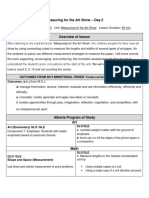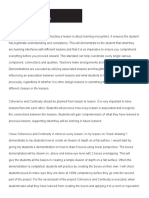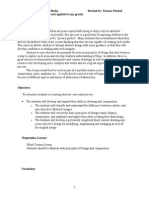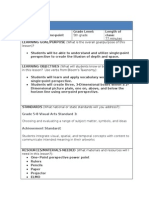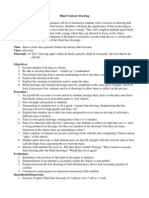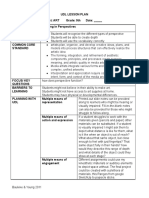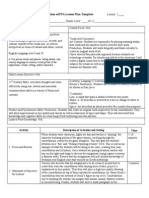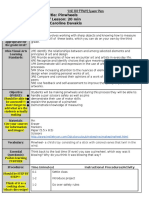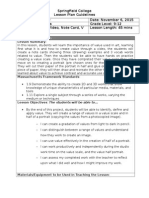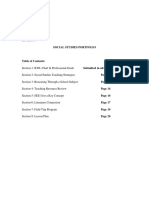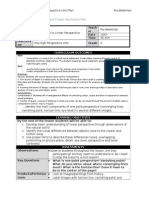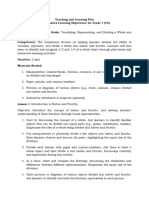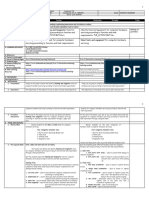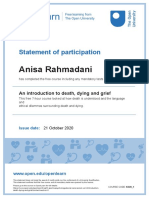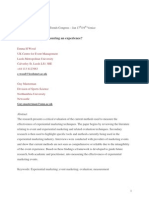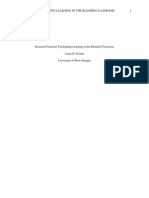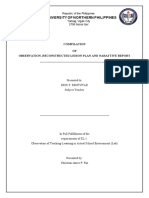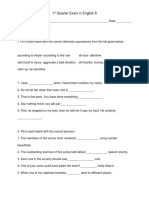Perspective Elijah Minton
Perspective Elijah Minton
Uploaded by
REBUSORA BTLED IACopyright:
Available Formats
Perspective Elijah Minton
Perspective Elijah Minton
Uploaded by
REBUSORA BTLED IACopyright
Available Formats
Share this document
Did you find this document useful?
Is this content inappropriate?
Copyright:
Available Formats
Perspective Elijah Minton
Perspective Elijah Minton
Uploaded by
REBUSORA BTLED IACopyright:
Available Formats
PERSPECTIVE DRAWING LESSON PLAN
Lesson Plan Prepared by Elijah Minton, IG: @theartalchemist
GOALS
Thrive Collective provides project-based learning that teaches both art and life skills. To the
extent possible, every lesson plan provides three clear goals. First, what art skill, subject area,
or big idea is being taught (the art “learning”)? Second, what will the students produce by the
end of the class (the “project”)? Third, how does that art skill translate into an everyday life skill
(the life “learning”)?
1. This class will teach students how to visualize and draw simple images from different
perspectives.
2. By the end of the class, students will understand the terms associated with perspective
drawing. Each student will use either one point or two point perspective to sketch an item
from their home.
3. Students will be introduced to how perspective drawing relates to life outside the
classroom by observing how one’s visual and mental perception is dependent on the
position of the observer. The ability to examine people, places, and experiences from
multiple perspectives is necessary for critical thinking in the real world.
MATERIALS
Pencil, paper, eraser.
Optional: Colored pencils, paint, markers, ink, highlighters, charcoal, pen, ruler.
EXPECTATIONS
Perspective drawing is how we draw 3 dimensional figures on a 2 dimensional surface.
This exercise will work best with students between the ages of 10 - 17. Older students will
naturally be able to grasp these concepts more easily and some may even be ready to explore
3 point perspectives. Use your discretion to determine if this may be the case.
Thrive Collective • (347)921-4426 • info@thrivecollective.org • www.thrivecollective.org
WHAT TO SHOW
HOW TO DRAW 1 POINT PERSPECTIVE FOR BEGINNERS
(To explain the basics of horizon lines, vanishing points, and perspective)
How to Draw 2 Point Perspective for Beginners
(explores the concept of 2 point perspective)
The following example is from M.C. Escher who was known for his extreme use of perspective
to create optical illusions.
WHAT TO TELL
Your primary focus should be to create a solid understanding of how perspective is defined.
Perspective is a fundamental art skill which will empower students with an ability to create depth
and space in their drawings. Creating a space where students feel safe and comfortable enough
to take a risk and try something that they may have never done before is also a primary
concern. Be aware that the directions you give can be too restrictive and stifle creativity and in a
twist of paradox, the same can be said about giving too much freedom in your directions.
Thrive Collective • (347)921-4426 • info@thrivecollective.org • www.thrivecollective.org
CLASS OUTLINE (30-50 Minutes)
PROJECT: PERSPECTIVE
OBJECTIVE
Through this lesson plan, students will:
● Be introduced to perspective, horizon lines, vanishing points, as well as one point
perspective.
● Draw an example using the edge of a table as a horizon line and a regular household
object in 3 dimensional form from one and two point perspective.
● Be asked to think of instances where perspective is important in making a decision
(sports, problem solving, etc.).
STEP 1 (5-10 minutes)
DEMO
Show students the youtube video “How to draw 1 point perspective for beginners.” Afterwards,
demonstrate by drawing a rectangle to create an example of one point perspective on paper.
CLASS WORK
Students will now create a perspective drawing using horizon lines, vanishing points, and
rectangles or squares. The students will only work with simple rectangles to help them begin to
grasp the basic concepts visually.
GROUP CHECK-IN / PRESENTATIONS
Ask students to identify which sides of the rectangle would be hidden from view as well as which
sides would be visible to the observer.
Note: Encourage the children to use straight edges like the side of a book or a few stacks of
paper folded over if they don’t have a ruler.
STEP 2 (5-10 minutes)
DEMO
Use skills learned from the demo Step 1 to draw an object with perspective using horizon lines
and vanishing points. Use a rectangular shaped household item to illustrate how the concepts
apply to the real world. Try to avoid using objects with a lot of round edges.
CLASS WORK
Now have each student use an object from home and attempt to apply perspective techniques.
Thrive Collective • (347)921-4426 • info@thrivecollective.org • www.thrivecollective.org
GROUP CHECK-IN / PRESENTATIONS
Ask students to identify which sides of the object would be visible and which sides of the object
are hidden. Ask students to come up with examples of how viewing an object from one
perspective can lead to false conclusions. The main point is to identify how multiple
perspectives are needed to see the entire picture. This also applies to life.
good example to use is a box with one side colored different from the rest. With this one
Note: A
side out of view, you can ask them what color the box is, then by turning it, you reveal that they
only had partial information and made conclusions without gathering all facts. A nother good
example can be to use a rubix cube.
STEP 3 (15-20 minutes)
DEMO
Use perspective techniques to draw an object from two opposite perspectives.
Color in sides that are visible in each drawing and point out that both perspectives are
necessary to see the bigger picture. Show students the youtube video “How to draw 2 point
perspective for beginners.”
CLASS WORK
Students will repeat the demo and follow with group discussion on what they learned.
GROUP CHECK-IN / PRESENTATIONS
Group discussion of what was learned.
STEP 4 (5-10 minutes)
DEMO
Use 2 objects to create a perspective drawing. One subject will be in the background and the
other in the foreground. Then draw both objects at an even depth to show how scale impacts
the illusion of distance.
CLASS WORK
Students will create two perspective drawings with two objects from home to repeat the demo.
GROUP CHECK-IN / PRESENTATIONS
Each student will present their drawing to the class and briefly explain why they chose the
items.
ave the students explain in words what they have observed through this exercise and
Note: H
encourage them to examine multiple perspectives when making decisions in real life.
Thrive Collective • (347)921-4426 • info@thrivecollective.org • www.thrivecollective.org
You might also like
- Grid DrawingDocument5 pagesGrid Drawingapi-29642352175% (4)
- Derived Relational Responding Applications For Learners (2009) PDFDocument402 pagesDerived Relational Responding Applications For Learners (2009) PDFMayra Gómez Lugo100% (1)
- Eei Lesson Plan Additive and Subtractive Tiles Semester 2Document4 pagesEei Lesson Plan Additive and Subtractive Tiles Semester 2api-317794487No ratings yet
- Integrative Theory of PeaceDocument14 pagesIntegrative Theory of Peaceapi-40335171350% (6)
- Module 14 - Taking Charge of One's Health and Well-BeingDocument10 pagesModule 14 - Taking Charge of One's Health and Well-BeingFelicity SanchezNo ratings yet
- Art 1 Drawing Lesson PlanDocument5 pagesArt 1 Drawing Lesson Planapi-457882818No ratings yet
- Measuring For The Art Show - Day 2Document6 pagesMeasuring For The Art Show - Day 2api-283081427No ratings yet
- Temple Standard:: Coherence and ContinuityDocument7 pagesTemple Standard:: Coherence and ContinuityJohn MooreNo ratings yet
- Rational:: Introducing Abstraction - Becky Revised By: Deanna Plested Grade 5 (May Be Modified and Applied To Any Grade)Document6 pagesRational:: Introducing Abstraction - Becky Revised By: Deanna Plested Grade 5 (May Be Modified and Applied To Any Grade)api-264279988No ratings yet
- Becky Drawing UnitDocument5 pagesBecky Drawing Unitapi-273390483No ratings yet
- Surreal Perspective Lesson PlanDocument9 pagesSurreal Perspective Lesson Planapi-220176001No ratings yet
- Perspective LessonDocument4 pagesPerspective LessonJessica CalhounNo ratings yet
- Lesson Plan 1 No ReflectionDocument8 pagesLesson Plan 1 No Reflectionapi-357424744No ratings yet
- Content Standard(s) Addressed by This LessonDocument6 pagesContent Standard(s) Addressed by This Lessonapi-335950861No ratings yet
- Lessonplan 2Document4 pagesLessonplan 2api-310441633No ratings yet
- Badger Di Lesson PlanDocument26 pagesBadger Di Lesson Planapi-236841699No ratings yet
- Blind Contour Line Drawing Lesson PlanDocument1 pageBlind Contour Line Drawing Lesson PlanFatimah MunirahNo ratings yet
- Lesson Plan-Vanishing PointDocument4 pagesLesson Plan-Vanishing Pointapi-625208229No ratings yet
- Drawing Outside The Box: Three Lesson Plan: DrawingDocument19 pagesDrawing Outside The Box: Three Lesson Plan: Drawingapi-273259841No ratings yet
- Kimm Pe11 Acei 2 5 EvidenceDocument27 pagesKimm Pe11 Acei 2 5 Evidenceapi-243095962No ratings yet
- Jasper Lynch Udl Lesson Plan Perspectives and BridgesDocument3 pagesJasper Lynch Udl Lesson Plan Perspectives and Bridgesapi-565572798No ratings yet
- Art Ed Lesson Plan Draft 2Document4 pagesArt Ed Lesson Plan Draft 2api-528624842No ratings yet
- C Canfield Edtpa Unit PlanDocument16 pagesC Canfield Edtpa Unit Planapi-242212465No ratings yet
- Kaseys Lesson PlanDocument3 pagesKaseys Lesson Planapi-277377772No ratings yet
- Art Tech Cubism LPDocument5 pagesArt Tech Cubism LPapi-457920671No ratings yet
- BPT Lesson IdeaDocument5 pagesBPT Lesson Ideaapi-554061413No ratings yet
- Perspective Lesson Plan 2Document3 pagesPerspective Lesson Plan 2api-439274434No ratings yet
- Installation Art: Lesson PlanDocument3 pagesInstallation Art: Lesson Planapi-337104406No ratings yet
- Length of Lesson: 20 Min Teacher: Caroline Davakis: VAE 101 FINAL Lesson Plan Lesson Title: PinwheelsDocument3 pagesLength of Lesson: 20 Min Teacher: Caroline Davakis: VAE 101 FINAL Lesson Plan Lesson Title: Pinwheelsapi-340160161No ratings yet
- Lesson Plan 1 - Falling Back Into Space 2Document3 pagesLesson Plan 1 - Falling Back Into Space 2api-242370085No ratings yet
- Measuring For The Art Show - Day 1Document6 pagesMeasuring For The Art Show - Day 1api-283081427No ratings yet
- DLP ARTs 3Document20 pagesDLP ARTs 3LORITO JR RETIZANo ratings yet
- Art 2 Unit 4Document9 pagesArt 2 Unit 4api-264152935No ratings yet
- Art Museum Lesson PlanDocument4 pagesArt Museum Lesson Planapi-316395005No ratings yet
- Digital PortfolioDocument184 pagesDigital Portfolioapi-298775308No ratings yet
- Arts Integration Lesson PlanDocument6 pagesArts Integration Lesson Planapi-434604005No ratings yet
- EDUC 5210 Unit 3 - AssignmentDocument6 pagesEDUC 5210 Unit 3 - Assignmentrobel berhaneNo ratings yet
- ClayslabmaskslpDocument9 pagesClayslabmaskslpapi-300148584No ratings yet
- M7a1 Lesson Plan - Initial SubmissionDocument2 pagesM7a1 Lesson Plan - Initial Submissionapi-286259630No ratings yet
- I. Lesson Number, Grade Levels, Title, and DurationDocument5 pagesI. Lesson Number, Grade Levels, Title, and Durationapi-309787871No ratings yet
- AbD Elaboration GameDocument2 pagesAbD Elaboration GameJenniNo ratings yet
- 7.1 LP Convex Lens From Various DistanceDocument7 pages7.1 LP Convex Lens From Various DistanceMiNH HayatNo ratings yet
- Value Lesson SCDocument5 pagesValue Lesson SCapi-296423521No ratings yet
- Sims PortfolioDocument24 pagesSims Portfolioapi-240050520No ratings yet
- Cut Out ProjectDocument5 pagesCut Out Projectapi-296423521No ratings yet
- Grade 9 Perspective Art UnitDocument11 pagesGrade 9 Perspective Art Unitapi-242345831100% (1)
- Gesture Drawing Lesson Plan Christine MccormickDocument5 pagesGesture Drawing Lesson Plan Christine Mccormickapi-313503065No ratings yet
- Grade 1TL Plan C6Document28 pagesGrade 1TL Plan C6Hannah Grace ValenciaNo ratings yet
- Assessment PortfolioDocument19 pagesAssessment Portfolioapi-273259841No ratings yet
- Mood CubesDocument16 pagesMood Cubesapi-541754489No ratings yet
- Lesson 5 Principles and Strategies in Teaching MathematicsDocument7 pagesLesson 5 Principles and Strategies in Teaching MathematicsJeorge HugnoNo ratings yet
- Sculpture Introduction Unit PlanDocument10 pagesSculpture Introduction Unit Planapi-267119096No ratings yet
- EDU 543 VAPA Lesson Plan Lesson Name and Content Area: Grade Level - 3 GradeDocument6 pagesEDU 543 VAPA Lesson Plan Lesson Name and Content Area: Grade Level - 3 Gradeapi-346211383No ratings yet
- Lessonplantemplate ArtcriticismDocument7 pagesLessonplantemplate Artcriticismapi-325088393No ratings yet
- FaceoffprojectDocument14 pagesFaceoffprojectapi-335950861No ratings yet
- BptsDocument2 pagesBptsapi-361030628No ratings yet
- Drawing Lessin PlanDocument2 pagesDrawing Lessin Planapi-343669487No ratings yet
- Plants Lesson PlanDocument3 pagesPlants Lesson Planjalexislopez13No ratings yet
- Lesson Plan: Curriculum ConnectionsDocument6 pagesLesson Plan: Curriculum Connectionsapi-311700306No ratings yet
- Lesson Plan OneppDocument4 pagesLesson Plan Oneppapi-515753148No ratings yet
- Service Learning Lesson Plan Template 20164Document6 pagesService Learning Lesson Plan Template 20164api-335950861No ratings yet
- Grow CreativityDocument5 pagesGrow Creativityapi-447662092No ratings yet
- ST WaiverDocument1 pageST WaiverREBUSORA BTLED IANo ratings yet
- DLL - 8 COMPUTER 3QUARTER - Week1Document8 pagesDLL - 8 COMPUTER 3QUARTER - Week1REBUSORA BTLED IANo ratings yet
- TQs 2Q G7 10 Answer KeyDocument11 pagesTQs 2Q G7 10 Answer KeyREBUSORA BTLED IANo ratings yet
- REBZ TMDI LESSON PLA-WPS OfficeDocument11 pagesREBZ TMDI LESSON PLA-WPS OfficeREBUSORA BTLED IANo ratings yet
- Module 9Document8 pagesModule 9REBUSORA BTLED IANo ratings yet
- Module-10 EimDocument5 pagesModule-10 EimREBUSORA BTLED IANo ratings yet
- Art: Grade 5 Unit 2: Perspective DrawingDocument12 pagesArt: Grade 5 Unit 2: Perspective DrawingREBUSORA BTLED IANo ratings yet
- Module 1 PDFDocument7 pagesModule 1 PDFREBUSORA BTLED IANo ratings yet
- MODULE 9 CDocument22 pagesMODULE 9 CREBUSORA BTLED IANo ratings yet
- Project Plan in CarpentryDocument3 pagesProject Plan in CarpentryREBUSORA BTLED IANo ratings yet
- Per Dev Week 2Document4 pagesPer Dev Week 2Andrey DyNo ratings yet
- Anisa Rahmadani: Statement of ParticipationDocument2 pagesAnisa Rahmadani: Statement of ParticipationAl ZurjaniNo ratings yet
- Folk Arts and Crafts of Caraga RegionDocument2 pagesFolk Arts and Crafts of Caraga RegionRose YnqueNo ratings yet
- Изменено - Grammar - Quiz PDFDocument1 pageИзменено - Grammar - Quiz PDFMargarita ShovkovskaNo ratings yet
- CDIT 151 CASE STUDY - Reflection SheetDocument2 pagesCDIT 151 CASE STUDY - Reflection SheetJackelinNo ratings yet
- Event Marketing: Measuring An Experience?Document27 pagesEvent Marketing: Measuring An Experience?Cyril ScariaNo ratings yet
- Me, Universal Landmarks and Outstanding Figures in Art, Literature, and HistoryDocument27 pagesMe, Universal Landmarks and Outstanding Figures in Art, Literature, and Historythe rose of snow زهرة الثلج100% (2)
- Reflection Journey Beyond PositivismDocument3 pagesReflection Journey Beyond PositivismDiane DuranNo ratings yet
- Dissertation Peut On Etre Esclave de Soi MemeDocument6 pagesDissertation Peut On Etre Esclave de Soi MemeBuyDissertationPaperJackson100% (1)
- IHUB Data Science Program BrochureDocument13 pagesIHUB Data Science Program BrochureRajat RajNo ratings yet
- Unit 3Document30 pagesUnit 3hdlove174No ratings yet
- Lesson 1 File 2 Can 4MSDocument5 pagesLesson 1 File 2 Can 4MSGoodie100% (2)
- CV DR Sajida ZakiDocument12 pagesCV DR Sajida ZakiXYZNo ratings yet
- 1703.03130 Stuctured Self-Attentive Sentence Embedding BenguioDocument15 pages1703.03130 Stuctured Self-Attentive Sentence Embedding Benguioai rednaNo ratings yet
- Reading Into Writing No Frills Airlines Discoursive EssayDocument3 pagesReading Into Writing No Frills Airlines Discoursive EssaypatriciaNo ratings yet
- Self-Rating Tool - ClosureDocument2 pagesSelf-Rating Tool - Closureapi-642188042No ratings yet
- Q1 ENGLISH DLP - Singular and Plural Noun 1Document7 pagesQ1 ENGLISH DLP - Singular and Plural Noun 1Abegail SugaboNo ratings yet
- Wilbur SchrammDocument3 pagesWilbur SchrammJenny Silaroy NiervaNo ratings yet
- Personality TraitsDocument42 pagesPersonality TraitsAnonymous jbqgiclCNNo ratings yet
- Edgenuity Research ProposalDocument27 pagesEdgenuity Research Proposalapi-499346657No ratings yet
- CompilationDocument117 pagesCompilationChristian james PazNo ratings yet
- 1st Quarter Exam in English 8Document4 pages1st Quarter Exam in English 8John Paul BasiñoNo ratings yet
- TEST and QUESTION TECHNIQUESDocument41 pagesTEST and QUESTION TECHNIQUESJastice TVNo ratings yet
- Cycles ApproachDocument28 pagesCycles ApproachBetül Özsoy TanrıkuluNo ratings yet
- g9 4th ExamDocument2 pagesg9 4th ExamBliss N RojasNo ratings yet
- Larong Pinoy C1 Rev.1Document7 pagesLarong Pinoy C1 Rev.1Leslie Ann BaguioNo ratings yet
- Lecture Notes Semantics and Grammar - CategoriesDocument4 pagesLecture Notes Semantics and Grammar - CategoriesDianaUt100% (1)






